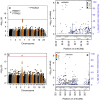Identifying genetically driven clinical phenotypes using linear mixed models
- PMID: 27109359
- PMCID: PMC4848547
- DOI: 10.1038/ncomms11433
Identifying genetically driven clinical phenotypes using linear mixed models
Abstract
We hypothesized that generalized linear mixed models (GLMMs), which estimate the additive genetic variance underlying phenotype variability, would facilitate rapid characterization of clinical phenotypes from an electronic health record. We evaluated 1,288 phenotypes in 29,349 subjects of European ancestry with single-nucleotide polymorphism (SNP) genotyping on the Illumina Exome Beadchip. We show that genetic liability estimates are primarily driven by SNPs identified by prior genome-wide association studies and SNPs within the human leukocyte antigen (HLA) region. We identify 44 (false discovery rate q<0.05) phenotypes associated with HLA SNP variation and show that hypothyroidism is genetically correlated with Type I diabetes (rG=0.31, s.e. 0.12, P=0.003). We also report novel SNP associations for hypothyroidism near HLA-DQA1/HLA-DQB1 at rs6906021 (combined odds ratio (OR)=1.2 (95% confidence interval (CI): 1.1-1.2), P=9.8 × 10(-11)) and for polymyalgia rheumatica near C6orf10 at rs6910071 (OR=1.5 (95% CI: 1.3-1.6), P=1.3 × 10(-10)). Phenome-wide application of GLMMs identifies phenotypes with important genetic drivers, and focusing on these phenotypes can identify novel genetic associations.
Figures


References
Publication types
MeSH terms
Substances
Grants and funding
LinkOut - more resources
Full Text Sources
Other Literature Sources
Research Materials

